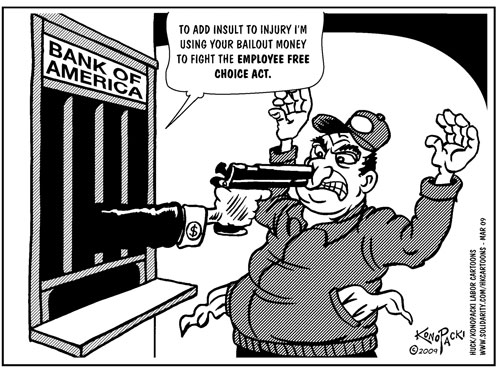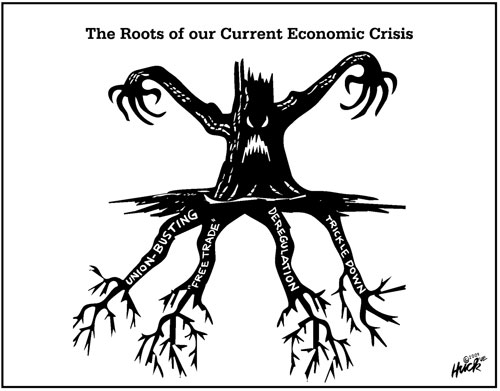posted
03/11/2009
Answering Our Critics: The Truth
About the Current Condition of the Auto Industry
by Region 8 Webmaster and LUPA Advisory
Board Chair John Davis
Over the past several months the U.S. Auto Industry
has been taking a licking everywhere from the pundits, to the bought
and paid for politicians, to the uninformed bloggers. There has
been much misinformation and down right lies told since news broke
about GM’s financial woes. Everywhere you turn there is some
conservative, anti-worker mouthpiece sharing their opinions on why
GM should be allowed to fail and the workers and retirees cast to
the wind. The disregard that is given to big three workers also
forgets the literally millions of other workers whose livelihood
is tied to the automotive industry.
Let’s examine some the statements that have been made and
look at the truth in what is said.
1. GM, Ford and Chrysler have made poor
business decisions and should fail. False. The
Big Three have taken a lot of flack for concentrating on trucks
and SUV’s. While it is true they did concentrate on these
markets, it is because that is what the market wanted. When the
escalation of gas prices hit, it was impossible for these companies
to retool over night to meet the demand for small cars. As a matter
of fact, most of the foreign transplants had desperately trying
to catch the Big Three on design and availability of trucks and
SUV’s to share in that market.
2. Union contracts have put the big three
in the shape they are in. False. Two years ago
the big three negotiated contracts with the UAW that included concessions
on virtually every aspect of the covered employees pay and benefits.
The pay and benefits of no employee in the country is scrutinized
the way auto workers are. Each contract year the press became  obsessed
with automotive pay. This contract closed the gap between union
represented companies and non-union workplaces such as the foreign
transplants. The Big Three were making huge strides at turning around
when the banking crisis hit last summer. This resulted in two things
happening. First, GM, Ford and Chrysler no longer had access to
loans they routinely made has part of doing business. This meant
they were forced to finance capital improvements out of their on
hand cash rather than borrow money. Then, overnight the general
public stopped buying cars. First through the failing economy and
then because lenders stop financing new vehicles for anyone who
fell below the very top credit rating. Only 25% of the buying market
qualified for a loan for a new vehicle. obsessed
with automotive pay. This contract closed the gap between union
represented companies and non-union workplaces such as the foreign
transplants. The Big Three were making huge strides at turning around
when the banking crisis hit last summer. This resulted in two things
happening. First, GM, Ford and Chrysler no longer had access to
loans they routinely made has part of doing business. This meant
they were forced to finance capital improvements out of their on
hand cash rather than borrow money. Then, overnight the general
public stopped buying cars. First through the failing economy and
then because lenders stop financing new vehicles for anyone who
fell below the very top credit rating. Only 25% of the buying market
qualified for a loan for a new vehicle.
To those who demand that workers be shredded of
their pay and benefits, namely Alabama Senator Richard Shelby and
Tennessee Senator Bob Corker, they should look at one important
fact. GM recently reported they lost 30.9 billion dollars in 2008.
If their 70,000 UAW workers averaged $70,000 a year (and few GM
worker’s made that much) that would have meant that GM spent
4.9 billion on worker’s wages. If GM had paid their hourly
employees nothing – remember these are the ones who actual
produced the vehicles sold – GM would have still lost $26
billion dollars. So, how can worker’s wages be blamed for
GM’s losses?
3. Big Three workers make $150,000 a
year for doing nothing. False. Let’s
say the average GM worker at $28 an hour worked every available
hour of overtime for the year. Could they have made that much? No.
At $28 per hour a 40 hour check is worth $1120. Let’s say
the worker  worked
12 hours (which is the limit you can work in a 24 hour period) a
day Monday through Friday. That is $840 more dollars when you consider
after 8 hours they made time and half. That brings us to $1960.
Then our worker works 8 hours on Saturday which adds $336 more dollars
at time and half and now puts the worker at $2296. Then the worker
adds 8 hours on Sunday at double time which adds $448 bringing the
total to $2744 for the week. I can tell you from experience that
a 74 hour week in an automotive plant is quiet taxing. If the worker
worked 74 hours a week for all 52 weeks in the year that comes to
$142,688. So those claims of GM workers making $150,000 a year are
not only impossible but also improbable based on the taxing demands
of the job. worked
12 hours (which is the limit you can work in a 24 hour period) a
day Monday through Friday. That is $840 more dollars when you consider
after 8 hours they made time and half. That brings us to $1960.
Then our worker works 8 hours on Saturday which adds $336 more dollars
at time and half and now puts the worker at $2296. Then the worker
adds 8 hours on Sunday at double time which adds $448 bringing the
total to $2744 for the week. I can tell you from experience that
a 74 hour week in an automotive plant is quiet taxing. If the worker
worked 74 hours a week for all 52 weeks in the year that comes to
$142,688. So those claims of GM workers making $150,000 a year are
not only impossible but also improbable based on the taxing demands
of the job.
4. Big Three workers are just drunks
who pay no attention to quality. False. In
the early 1980s the big three had trouble with quality issues. The
UAW fought for and won new language in the contract that gave workers
a voice in quality matters. Quality of the vehicles has long been
a concern for the UAW and the addition of programs such as the Quality
Network gave workers the right to stop production to address quality
issues for the first time. It was after the implementation of these
programs that the big three saw their quality match that if their
foreign rivals. Big three workers are very focused on building quality
parts. Jobs that pay a living wage such as in most of the automotive
sector, are not easily replaced so this gives automotive workers
an additional incentive to build in quality. Many of the bloggers
who claim to have first hand knowledge of drunk workers in the plant
are usually disgruntled salaried employees.
5. Richard Shelby as late as March 8,
2009 was still demanding that GM and Chrysler file bankruptcy and
shed their obligations to retirees rather than receive additional
bridge loans from the government. Shelby states he is against “wasting”
the taxpayer’s dollars. False. Richard
Shelby prides himself on being “watchdog” of the citizen’s
tax dollars, when nothing could be further from the truth. In the
past year Shelby has sponsored or co-sponsored a total of $647,263,200
in earmark spending according to legistorm.com. The bulk of that
has been for defense spending. As a matter of fact, sourcewatch.com
reports over the course of a decade (1996-2006), Shelby helped direct
$50 million to military projects benefiting the COLSA Corp., a space
and missile defense company. The firm’s owner, Francisco J.
Collazo, is a longtime friend of Shelby who contributed $400,000
to his campaigns and committees over this same period of time. In
1996, Collazo hired one of the senator’s former aides as his
lobbyist. So Shelby’s claim of “watching out for the
taxpayers” doesn’t hold water. MSN reported that on
the morning the House voted on the orginal bridge loan for the auto
industry in December, Shelby sent a memo to the Republicans in the
House demanding they vote no to “pay back labor” for
the 2008 elections.
In the report to Congress, GM planly outlined that
a bankrutpcy would cost the government as much as 100 billion dollars.
Shelby even stated that GM would have access to billions in government
dollars if they just filed bakrutpcy. How does this make more sense
than issuing a loan that will be paid back with interest? The bottom
line is the economy is much to fragile at the moment to absorb the
failure of the automotive sector. Politicans such as Richard Shelby
and Mitt Romney should be more concerned with perserving the democracy
and less worried about “political paybacks.” A failure
of the automotive industry would reek havic on the entire economy
not just those auto workers and retirees that so many in Washington
and on the message boards seem to loath.
|